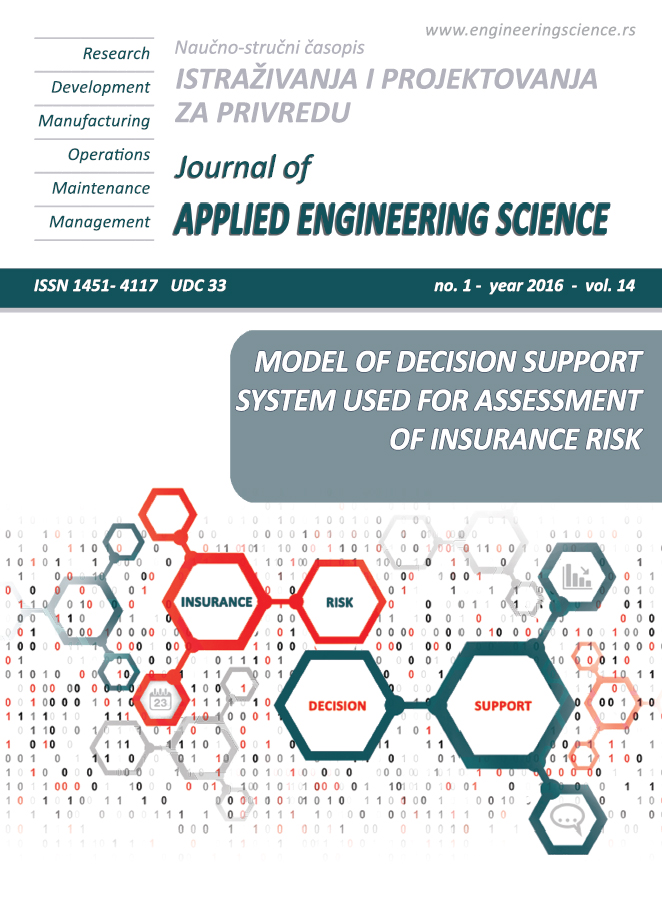ON THE IMPORTANCE OF MANAGERIAL AND ORGANISATIONAL VARIABLES IN THE QUANTITATIVE RISK ASSESSMENT
Abstract
Common practises for Quantitative Risk Assessment (QRA) include the estimation of frequencies of releases and related initial causes; these are a function of several parameters such as components failure rates, probabilities of human error, equipment damage and managerial factors. The availability of general values for such parameters from the literature simplifies the work of the risk analyst, but standardised results are provided, which unfortunately do not permit taking into consideration the plant’s specificity. The specificity of the establishment is defined through its management system, thus if managerial and organisational factors are neglected or not proper assessed, risk analysis for two identical establishments, characterised by totally different management systems, gives the same results and this appears absolutely unacceptable especially when risk analysis is used for risk-based decisions. This paper aims quantifying the effects of managerial and organisational variables on the frequency of losses of containment of pipeworks, by using a simple and flexible method developed by Milazzo and co-authors in 2010. Such a methodology has been tested on a new case-study and the results of the assessment have been evaluated from both the sensitivity and uncertainty points of view. An application has been shown with respect to the alkylation unit of a refinery.
References
Abrahamsen, E. B.,Asche, F., Milazzo, M.F. (2013) An evaluation of the effects on safety of using safety standards in major hazard industries. Safety Science, 59: 173-178.
Davoudian, K., Wu, J. S., Apostolakis, G., (1994) Incorporating organizational factors into risk assessment through the analysis of work processes, Reliability Engineering and System Safety, 45, 85-105.
Davoudian, K., Wu, J. S., Apostolakis, G. E., (1994) The work process analysis (WPAM II), Reliability Engineering and System Safety, 45(1-2), 107-125.
Embrey, D. E., (1992) Incorporating management and organization factors into probabilistic safety assessment, Reliability Engineering and System Safety, 38(1-2), 199-208.
Flage, R., Aven, T., (2009) Expressing and communicating uncertainty in relation to quantitative risk analysis (QRA), Reliability & Risk Analysis: Theory & Applications, 2(13), 9–18.
Flemish Government, LNE Department Environment, Nature and Energy Policy Unit Safety Reporting Division (2009), Handobook of failure frequencies (Appendix).
Gordon, R. P. E., (1998) The contribution of human factors to accidents in the offshore oil industry, Reliability Engineering and System Safety, 61, 95-108.
Healthy & Safety Executive, (2012) Failure Rate and Event Data for use within Risk Assessments. Report available at: http://www.hse.gov.uk/ (accessed on the 1st December 2015).
Izquiedo-Rocha, J. M., Sanchez-Perea M., (1994) Application of integrated safety assessment methodology to emergencies procedures of SGTR of a PWR, Reliability Engineering and System Safety, 45(1-2), 159-173.
Lees, F. P., (1996) Loss Prevention in the Process Industries, Elsevier, London.
Milazzo, M. F., Aven, T., (2012) An extended risk assessment approach for chemical plants applied to a study related to pipe ruptures, Reliability Engineering and System Safety, 99, 183-192.
Milazzo, M. F., Maschio, G., Uguccioni, G., (2009) Frequency assessment of loss of containment including the effects of measures of risk prevention, Reliability & Risk Analysis: Theory & Applications, 2(13), 118–130.
Milazzo, M. F., Maschio, G., Uguccioni, G., (2010) The influence of risk prevention measures on the frequency of failure of piping, International Journal of Performability Engineering, 6(1), 19-33.
Milazzo, M. F., Vianello, C, Maschio, G., (2015) Uncertainties in QRA: Analysis of losses of containment from piping and implications on risk prevention and mitigation, Journal of Loss Prevention in the Process Industry, 36, 98-107.
Modarres, M., Mosleh, A., Wreathall, J. A., (1992) Framework for assessing influence of organization on plant safety, Reliability Engineering and System Safety, 38(1-2), 157-171.
Montmayeul, R., Monsneron-Dupin, F., Llory, M., (1994) The managerial dilemma between the prescribed task and the real activity of operator: some trends for research on human factors, Reliability Engineering and System Safety, 45(1-2), 67-73.
Mosleh, A., Goldfeiz, E. B., (1995) An Approach for Assessment the Impact of Organizational Factors on Risk. Report no. UMNE-95-003, University of Maryland.
Nivolianitou, Z. S., Papazoglou, I. A., (1998) An auditing methodology for safety management of the Greek process industry, Reliability Engineering and System Safety, 60, 185-197.
Øien, K., (2001) A framework for the establishment of organizational risk indicators, Reliability Engineering and System Safety, 74(2), 147-167.
Papazoglou, I. A., Aneziris, O., (1999) On the quantification of the effects of organizational and management factors in chemical, Reliability Engineering and System Safety, 15(1): 545-554.
Papazoglou, I. A., Aneziris, O., Post, J. G., Ale, B. J. N., (2002) Technical modeling in integrated risk assessment of chemical installations, Journal of Loss Prevention in the Process Industry, 15(6), 545-554.
Papazoglou, I. A., Bellamy, L. J., Hale, A. R., Aneziris, O., Post, J. G., Oh, J. I. H., (2003) I-Risk: development of an integrated technical and management risk methodology for chemical installations,. Journal of Loss Prevention in the Process Industry, 16(6), 575-591.
Patè-Cornell, E. M., Murphy, D. M., (1996), Human and management factors in probabilistic risk analysis: the SAM approach and observations from recent applications, Reliability Engineering and System Safety, 53(2), 115-126.
Salvi, O., Debray, B., (2005) A global view on ARAMIS, a risk assessment methodology for industries in the framework of the SEVESO II directive, Journal of Hazardous Materials, 130(3), 187-199.
Schönbeck, M., Rausand, M., Rouvroye, J., (2010) Human and organisational factors in the operational phase of safety instrumented systems: A new approach, Safety Science, 48(3), 310-318.
Vianello C., Guerrini L., Maschio G., Mura A. (2014). Consequence analysis: comparison of methodologies under API standard and commercial software. Chemical Engineering Transactions, 36, 511-516.

